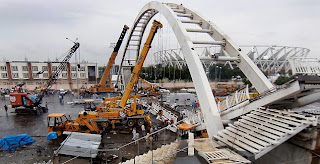
With the commonwealth games just days away, Authorities in India shiver after shambolic pre games preparation efforts that have been protracted over half a decade.
It was a day of elation and celebration as the biggest democracy of the world got hold of, what was thought at that point, a giant step towards holding the Olympics or the soccer world cup. But, that was more of an ambition of a nation looking to be a world power by 2020, today; this all seems a fairytale turned into a nightmare. But being from the same part of the world, this has not come as a surprise for me. Except for Cricket, which is more of a religion in India, the nation lags miles behind the world in terms of facilities and infrastructure. So much so, that few of the world events before this fiasco were on the brink of being shifted to Europe or Australia.
If anyone has interest in field hockey, he would remember the kind of administrative struggle IHF (Indian Hockey Federation) faced earlier this year in holding the world cup. So much so, that the federation was dissolved and elections were held in lightning speed to bring a sort of transparency at the helm. An infrastructure failure lead to a disastrous badminton world championships a few years back with water dripping at the indoor stadium . Hence this is not the first time and with the things the way it is, this does not look like the last time.
So, what is wrong with a nation that has got world class sportspersons, scholars and business minds? Someone alien to conditions in India would be asking why is the nation so much obsessed about holding world events when it struggles to do so? The answer lies in the kind of commitment organizers, administrators and the national government shows in something that do not directly impact them in person. Well, then how come the same country boasts of two successful cricket world cups and the path breaking Asian Games of 1982. Again, the answer lies in the level of commitment.
Let’s look at cricket, a sport run by an autonomous body, BCCI (Board of control for cricket in India). Jagmohan Dalmiya, the head of the BCCI during the mid 90s vowed to make cricket a marketable commodity. He was the kingpin in bidding and winning the right to host the 1996 world cup cricket jointly with neighboring Pakistan and Sri Lanka. A path breaking event, which showed India as a nation which means business and which is second to none. But, all this did not happen in matter of days. From the day the vision of an event of such magnitude was thought off, till the day the first ball of practice matches were bowled, BCCI did everything to make the event, one of a lifetime, and by the time the final was held at Gaddafi Stadium in Lahore, the board and the world cup organizing committee received unprecedented praise from all over the world. Yes, in 1996, the infrastructure was more or less ready, but how? It was because in 1987, with the world cup looming, Raj Singh Dongarpur marketed the event to the corporate world from which a clothing and warehouse firm came forward to sponsor the event. Again a kind of effort that the commonwealth games of today yearns for. Imilarly, Indira Gandhi, the then Prime Minister of India, took the things in her hands in order to make the 1982 Asian Games a showcase to show the world where India stands after three and a half decade of independence. Hence if we look closely, the one thing common to these three organizational success is a sense of pride and a level of sheer commitment on the part of the government and administrator in order to showcase the best they have to offer.
Now, let us analyze how India went about the commonwealth games. The nation bid for the games as it had done a few times before, may be having a notion that the bid may fail again. Ironically and should I say against the expectations of the bid committee the only other nation reaching the final bid stage was Canada. Since the North American nation wanted to host the winter Olympics, it did not go full fledge for the other bid and hurray, India gets the chance to host the second largest games in terms of nations after the Olympics.
This clearly shows the fault start to a marathon of hosting a global sporting event that started about six years back. The marathon turned into a 100 meter dash which is now right at the home stretch and probably that is a real life proof why a fault start means a fresh start for any athletic event. But in the case of CWG 2010, it transformed into an ordeal which I fear may end up marring the image of a nation which is aiming to be shanghai by 2015.
Hence I believe, unless administrators, like the sports minister who compares this event to a typical Indian wedding in which everything is haphazard before the main ceremony but on the D Day all falls in place, are replaced by event management gurus, India will remain an aspirant of hosting an Olympics.